Related Research Articles

Interstellar travel is the hypothetical travel of spacecraft from one star system, solitary star, or planetary system to another. Interstellar travel is expected to prove much more difficult than interplanetary spaceflight due to the vast difference in the scale of the involved distances. Whereas the distance between any two planets in the Solar System is less than 30 astronomical units (AU), stars are typically separated by hundreds of thousands of AU, causing these distances to typically be expressed instead in light-years. Because of the vastness of these distances, non-generational interstellar travel based on known physics would need to occur at a high percentage of the speed of light; even so, travel times would be long, at least decades and perhaps millennia or longer.

Interplanetary spaceflight or interplanetary travel is the crewed or uncrewed travel between stars and planets, usually within a single planetary system. In practice, spaceflights of this type are confined to travel between the planets of the Solar System. Uncrewed space probes have flown to all the observed planets in the Solar System as well as to dwarf planets Pluto and Ceres, and several asteroids. Orbiters and landers return more information than fly-by missions. Crewed flights have landed on the Moon and have been planned, from time to time, for Mars, Venus and Mercury. While many scientists appreciate the knowledge value that uncrewed flights provide, the value of crewed missions is more controversial. Science fiction writers propose a number of benefits, including the mining of asteroids, access to solar power, and room for colonization in the event of an Earth catastrophe.
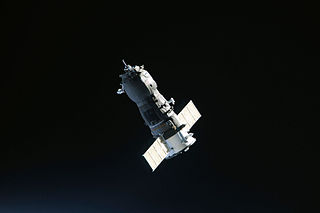
Robotic spacecraft or uncrewed spacecraft are spacecraft without people onboard. Uncrewed spacecraft may have varying levels of autonomy from human input; they may be remote controlled, remote guided or even autonomous, meaning they have a pre-programmed list of operations, which they will execute unless otherwise instructed. A robotic spacecraft designed to make scientific research measurements is often called a space probe or space observatory.

A life-support system is the combination of equipment that allows survival in an environment or situation that would not support that life in its absence. It is generally applied to systems supporting human life in situations where the outside environment is hostile, such as outer space or underwater, or medical situations where the health of the person is compromised to the extent that the risk of death would be high without the function of the equipment.
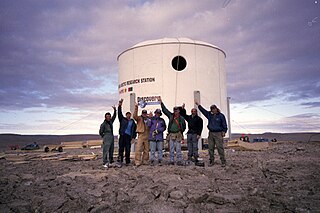
The Flashline Mars Arctic Research Station (FMARS) is the first of two simulated Mars habitats located on Devon Island, Nunavut, Canada, which is owned and operated by the Mars Society. The station is a member of the EU-INTERACT, circumarctic network of currently 89 terrestrial field bases located in northern Europe, Russia, US, Canada, Greenland, Iceland, the Faroe Islands, and Scotland as well as stations in northern alpine areas.

The MARS-500 mission was a psychosocial isolation experiment conducted between 2007 and 2011 by Russia, the European Space Agency, and China, in preparation for an unspecified future crewed spaceflight to the planet Mars. The experiment's facility was located at the Russian Academy of Sciences' Institute of Biomedical Problems (IBMP) in Moscow, Russia.
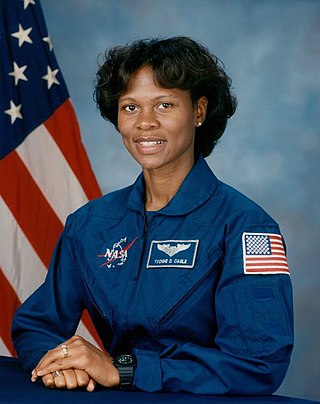
Yvonne Darlene Cagle is an American physician, professor, retired U.S. Air Force Colonel, and former NASA Astronaut. Cagle joined NASA as an astronaut in 1996. She is one of six African American female astronauts.

The following outline is provided as an overview of and topical guide to space exploration.
Sarah Jane Pell is an Australian artist, researcher and occupational diver. Her works combine the traditions of Performance art and human factors with Underwater habitat and Occupational diving technologies. She is best known for pioneering "aquabatics" that is performed underwater or shown in museums as films and artefacts. She designs civilian space-analogues and produces speculative fiction, live art, and novel experiments.
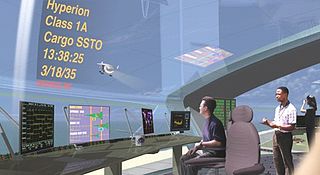
Space trade is interplanetary or interstellar trade. Plans and ideas on how trade functions have been published by Futurists and pundits since the 1960s, though science fiction writers have been envisioning such trade for several more decades.
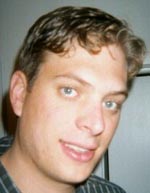
Jonathan Robert Dory is a Human Systems Integration Lead at NASA's Johnson Space Center (JSC) in Houston, Texas. He is Branch Chief of NASA's Habitability and Human Factors Branch, part of the Habitability and Environmental Factors Division at NASA/JSC. Dory supports crew safety and productivity on the International Space Station (ISS) Program by planning and assessing the on-orbit interior configuration of ISS, as well as performing anthropometric analysis of crew tasks. He contributes to the integrated operation of the Space Station while using 3D computer graphics and animation software as part of his daily work. In July 2002, Dory served as an aquanaut on the NASA Extreme Environment Mission Operations 3 crew.

Vladimir Pletser is Visiting Professor – Scientific Adviser at the Technology and Engineering Centre for Space Utilization (CSU) of the Chinese Academy of Sciences in Beijing, China, since April 2016. He supports the preparation of scientific experiments in microgravity for the future Chinese Space Station and for aircraft parabolic flights. He worked previously from 1985 till early 2016 as senior Physicist-Engineer at the European Space Research and Technology Centre (ESTEC) of ESA.
Terrestrial analogue sites are places on Earth with assumed past or present geological, environmental or biological conditions of a celestial body such as the Moon or Mars. Analogue sites are used in the frame of space exploration to either study geological or biological processes observed on other planets, or to prepare astronauts for surface extra-vehicular activity.
Dr. Yajaira Sierra-Sastre is a Puerto Rican materials scientist, educator, and aspiring astronaut. She was part of a six-person crew, and the only Hispanic, selected to participate in a four-month-long, Mars analog mission funded by NASA. Sierra-Sastre aspires to become the first Puerto Rican woman to travel to outer space.

The Hawaii Space Exploration Analog and Simulation (HI-SEAS) is an analog habitat for human spaceflight to Mars currently operated by the International MoonBase Alliance. HI-SEAS is located in an isolated position on the slopes of the Mauna Loa volcano on the island of Hawaii. The area has Mars-like features and an elevation of approximately 8,200 feet (2,500 m) above sea level. The first HI-SEAS study was in 2013 and NASA's Human Research Program continues to fund and sponsor follow-up studies. The missions are of extended duration from four months to a year. Its missions place HI-SEAS in the company of a small group of analogs that are capable of operating very long duration missions in isolated and confined environments, such as Mars500, Concordia, and the International Space Station.
A Mars analog habitat is one of several historical, existing or proposed research stations designed to simulate the physical and psychological environment of a Martian exploration mission. These habitats are used to study the equipment and techniques that will be used to analyze the surface of Mars during a future crewed mission, and the simulated isolation of the volunteer inhabitants allows scientists to study the medical and psychosocial effects of long-term space missions. They are often constructed in support of extensive Mars analogs. However, sometimes existing natural places are also valued as Mars analogs. Crewed Mars habitats are featured in most human Mars missions; an alternative may be terraforming or telepresence.

Sian Hayley "Leo" Proctor is an American commercial astronaut, geology professor, and science communicator. On September 15, 2021, she was launched into Earth's orbit as the pilot of the Crew Dragon space capsule. This mission was the Inspiration4 private orbital spaceflight. As the pilot on this mission, Proctor became the first African American woman to pilot a spacecraft. She was also the education outreach officer for the first Hawai’i Space Exploration Analog and Simulation (HI-SEAS) Mission. Proctor is a geology professor at South Mountain Community College in Phoenix. She is also a Major in the Civil Air Patrol where she serves as the aerospace education officer for its Arizona Wing.
The International Lunar Exploration Working Group(ILEWG) is a public forum sponsored by the world's space agencies to support "international cooperation towards a world strategy for the exploration and utilization of the Moon - our natural satellite".
References
- N.N. (2012). "Witteveen+Bos Art+Technology Award 2012". Witteveen+Bos. ISBN 978-94-90335-05-2
- Pain, Elisabeth (2009). "The Itinerant artist". in: Science. March 2009. Web. 4 May 2013.
- Resseler, Yvonne (2008). "Conversation avec Yvonne Resseler". Éditions Tandem. ISBN 978-2-87349-060-7
- Steveheydens, Ive (2006). "Games zijn extreem zintuiglijk". in: Etcetera. Vol 24, Iss. 100, pp 53 – 57. print
- Steveheydens, Ive (2004). "Angelo Vermeulen – De denkmachines van een wetenschappelijke charlatan". in: Martens, Hans (ed.). Oogst/Récolte/Harvest. Provinciale Prijs voor Beeldende Kunst 2003. Ghent. Provincie Oost-Vlaanderen. ISBN 90-76686-20-3
- Thysens, Margot (2012). "Angelo Vermeulen. Van biologie & fotografie tot mediakunst". in: Beeld Express. 2012, Iss. 5, pp 22 – 27. print.
- Van Dijk, Thomas (2013). "Making meals on Mars". in: TU Delta. 26 February 2013. Web. https://web.archive.org/web/20130621102635/http://delta.tudelft.nl/artikel/making-meals-on-mars/26367
- Wynants, Marleen and Jan Cornelis (eds.) (2007). Brave new interfaces. Individual, Social and Economic Impact of the Next Generation Interfaces. Brussels: VUB Press. ISBN 9789054874164